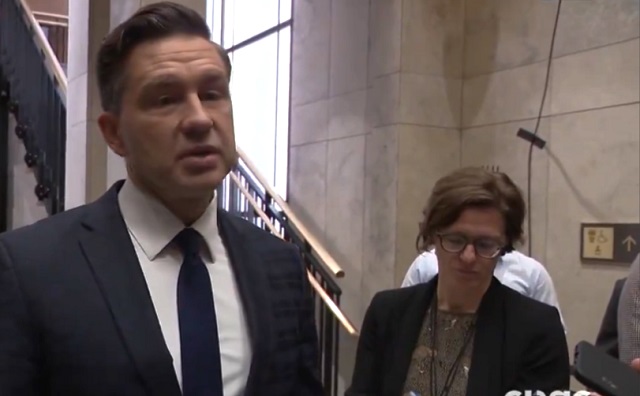National
Conservatives plan non-confidence vote against Trudeau gov’t next week, setting up possible fall election

From LifeSiteNews
Conservative Party leader Pierre Poilievre said ‘it’s time to put forward a motion for a carbon tax election’
The Conservative Party of Canada (CPC) will bring a motion of non-confidence in the House of Commons as early as next week, it has now been confirmed by party leader Pierre Poilievre.
Speaking with reporters today in Ottawa, Poilievre confirmed that a confidence motion will soon be introduced.
“It’s time to put forward a motion for a carbon tax election,” he said, adding that an election is needed because the Trudeau Liberals plan to raise the carbon tax another 300 percent in the coming years.
“Canadians can vote to axe the tax, build the homes, fix the budget, and stop the crime with a common-sense Conservative government.”
CPC Branden Leslie on X today confirmed the forthcoming confidence motion as well.
“It’s official that next week, Conservatives will introduce a motion of non-confidence in the House of Commons,” he said.
“Please SHARE this post to send the NDP a message that Canadians want a carbon tax election NOW!”
The text of the non-confidence motion will read, “The House has no confidence in the Prime Minister and the Government.”
An earlier report from the Toronto Star said sources let it be known that Trudeau’s government will let a confidence motion proceed as early as September 24. On this day, Poilievre will be allowed to have full control of the House’s agenda and introduce motions at will.
While it is traditional confidence motions are used mainly when it comes to budget, they can also be brought forth for other reasons as well. The CPC will need the support of Jagmeet Singh’s New Democratic Party (NDP) at a minimum and the Bloc Québécois. Should the initial motion or any others pass, Trudeau will have no choice but to dissolve parliament, which would trigger a general election, most likely in November.
The confidence motion comes after Trudeau lost support from the socialist NDP to keep him in power. Singh pulled his official support for Trudeau’s Liberals two weeks ago. However, in recent days he has been mum on whether he will vote for or against the Liberals when a vote occurs.
The Trudeau Liberals have also lost two recent byelections, one in Quebec and the other in Ontario, in what were considered “safe” Liberal ridings.
The most recent loss suggests that Trudeau’s Liberal government is indeed hanging on by a thread, according to all recent polls that have shown that Poilievre’s Conservative Party is set to win big when the next federal election takes place.
The souring of voters to the Liberal Party under Trudeau comes at the same time that even some of his MPs are turning on him. Last week, LifeSiteNews reported that Liberal MP Alexandra Mendès, who serves as the assistant deputy speaker of the House of Commons, became the first in the party to publicly call for Trudeau to resign, saying directly that he is not the “right leader” for the party.
International
Poilievre, Carney show support for Maduro capture as NDP’s interim leader denounces it

From LifeSiteNews
Conservative Party leader Pierre Poilievre happily welcomed the capture of Venezuelan dictator Nicolás Maduro by the United States on Saturday and Canadian Prime Minister Mark Carney seemed to approve 0as well.
In a statement posted to X over the weekend, Poilievre, whose wife is from Venezuela, thanked U.S. President Donald Trump for the capture of Maduro.
“Congratulations to President Trump on successfully arresting narco-terrorist and socialist dictator Nicolas Maduro, who should live out his days in prison,” Poilievre wrote.
Poilievre said that the “legitimate winner of the most recent Venezuelan elections, Edmundo González,” should take office, along with the courageous hero and voice of the Venezuelan people, María Corina Machado.”
“Down with socialism. Long live freedom,” he added.
As for Carney, in a social media statement Saturday, he noted how Canada had imposed sanctions on Maduro’s “brutally oppressive and criminal regime — unequivocally condemning his grave breaches of international peace and security, gross and systematic human rights violations, and corruption.”
“Canada has not recognized the illegitimate regime of Maduro since it stole the 2018 election,” he wrote.
“The Canadian government therefore welcomes the opportunity for freedom, democracy, peace, and prosperity for the Venezuelan people.”
As reported by LifeSiteNews, on January 3, U.S. special forces captured Maduro and flew him out of Venezuela in a sophisticated military operation. Maduro’s wife, Cilia Flores, was captured as well, and both were taken to New York, where they have been charged with drug trafficking.
While Canada’s two main political parties celebrated Maduro’s capture, the interim leader of the socialist New Democratic Party condemned actions by the Trump administration.
Don Davies said on social media that the “attack on Venezuela is neither an act of self defence nor does it have UN Security Council authorization.”
“It is therefore totally illegal and a breach of the UN covenants the US has agreed to uphold as a Member State,” he claimed.
He also said, “The U.S. can have no credibility upholding international law and the rights of nations when it blatantly violates those principles itself.”
U.S. Attorney General Pam Bondi’s indictment of Maduro’s regime accuses it of working to transport “thousands of tons of cocaine to the United States” and says that he “partnered with some of the most violent and prolific drug traffickers and narco-terrorists in the world” to flood the U.S. with the deadly drug.
Trump has said that the United States will now have access to oil that belongs to them, and that the United States will “run” Venezuela temporarily to provide for a “safe transition.”
As for Maduro, he rose to power in 2013 after the death of far-left president Hugo Chávez.
Venezuelan special forces committed more than 5,000 extrajudicial killings in 2018 alone, according to a United Nations report.
The Maduro regime was also responsible for jailing thousands of protesters and other people classified as political opponents and frequently tortured and abused prisoners, human rights groups have attested.
Also, the Maduro regime has engaged in anti-Catholic persecutions. In December, Venezuelan authorities blocked Cardinal Baltazar Porras, the 81-year-old former archbishop of Caracas, from boarding a flight out of the country, detaining him, confiscating his Venezuelan passport, and rejecting his Vatican passport.
Under Maduro’s leadership, Venezuela has suffered a catastrophic economic collapse due to his and Chavez’s socialist policies, including price controls, massive public spending, and the nationalization of major industries.
Business
Chrystia Freeland Didn’t Leave Power. She Just Took It Somewhere Else

Canadians were told freezing bank accounts was “necessary.” We were told sending billions overseas without a vote was “solidarity.” And now we’re told that Chrystia Freeland the architect of some of the most aggressive financial overreach in modern Canadian history advising a foreign government on economic policy is “normal.” It isn’t. It’s a closed circle of power rewarding itself, while ordinary Canadians are expected to forget what was done to them and quietly foot the bill.
I don’t believe in coincidences in politics and I don’t believe in “honourary” appointments when billions of dollars and unchecked power are involved. So when Chrystia Freeland, the same woman who helped freeze Canadians’ bank accounts, torched public trust, and oversaw economic decisions that hollowed out this country is suddenly appointed as an economic adviser to Ukraine, Canadians should stop and ask a very uncomfortable question.
Kelsi Sheren is a reader-supported publication.
To receive new posts and support my work, consider becoming a free or paid subscriber.
Who exactly is Chrystia serving? Because it doesn’t look like us and doesn’t feel like us at all. I’m going to make something very clear and spell it out for Canadians… this is the same elite just moved to a different country.
Chrystia Freeland did not leave politics because she failed. She didn’t resign because she was rejected. She exited after years of consolidating power at the highest levels of government and immediately landed an advisory role with a foreign head of state.
That is not a fall from grace. That is a lateral move inside the same elite ecosystem.
Multiple Canadian outlets have now confirmed that Freeland has been named an economic adviser to Ukrainian President Zelenskyy. This is not symbolic. This is not charity. This is about economic reconstruction, international financing, sanctions, and the movement of billions of dollars, much of it, if not all of it is Western taxpayer money.
Including ours.
Has everyone forgotten what this women did to Canadians?? Before anyone starts calling this “statesmanship,” let’s remember the record.
Chrystia Freeland was a central figure during one of the most dangerous moments in modern Canadian governance: the normalization of financial punishment against citizens.
Under her watch, the federal government froze bank accounts without criminal charges, without due process, and without judicial oversight. Whatever your view of the Freedom Convoy, that precedent should have terrified you and if it doesn’t you need to wake up.
Once a government proves it can financially erase you for dissent, it never unlearns that lesson.
She also presided over years of reckless spending, inflationary pressure, and policies that pushed Canadians into a cost-of-living crisis while telling them everything was fine. Housing exploded. Food prices surged. Small businesses collapsed.
And now — suddenly — she’s being handed influence over another country’s economic future? The money no one voted on is now gone with no recourse and she knows it.
Canada has already sent billions of dollars to Ukraine, including roughly $2.5 billion tied to frozen Russian assets — without any direct vote from Canadians and with minimal parliamentary scrutiny.
Let that sit for a minute.
Our government helped set a precedent where foreign sovereign assets are frozen, leveraged, and redirected — and now one of the architects of that approach is advising the very government receiving the funds.
You don’t need to be a lawyer to understand how rotten that looks. At minimum, this is a conflict of interest. At worst, it’s a closed-loop system where the same political actors make the rules, move the money, and then step into advisory roles on the receiving end.
That’s not democracy. That’s managed power. People will say, “Ukraine needs help rebuilding.” Fine. That’s not the argument. The argument is who decides, who benefits, and who is accountable.
Chrystia Freeland still carries enormous influence inside Canada’s political and financial institutions. Her appointment creates a pipeline — informal, opaque, and unaccountable between Canadian decision-makers and a foreign government dependent on Western funds.
If an average Canadian MP took a paid or unpaid advisory role with a foreign government, alarms would be ringing, but when it’s Chrystia Freeland, we’re told it’s noble. Necessary. Above criticism.
That’s how corruption survives. Not through secrecy, but through normalization.
Canadians are always last, here’s the pattern Canadians are starting to see clearly, I hope. Canadians are being forced to tighten their belts. Canadians lose purchasing power on almost everything and Canadians are told to accept less and the sad part is Canadians are good with this.
Meanwhile, political elites move effortlessly between governments, NGOs, global institutions, and advisory boards. All it is, is different flags. Same class of people.
The people who suffered under Freeland’s economic policies don’t get to resign into prestige. They get debt. They get anxiety. They get silence.
She gets influence.
In case your wondering, this isn’t really about Ukraine, this is not an attack on Ukraine or its people. This is about Canadian democracy, accountability, and the dangerous precedent being set when unelected influence replaces public consent.
If Canadians are expected to fund wars, reconstruction, and foreign policy projects — then Canadians deserve transparency, debate, and representation.
Instead, we’re getting appointments behind closed doors and press releases that assume we won’t ask questions.
That era is long over.
Chrystia Freeland didn’t disappear. She didn’t retreat. She repositioned.
If Canadians don’t start calling this what it is — elite continuity without consent — then we shouldn’t be surprised when the same tactics used against citizens at home are exported abroad.
Power always practices somewhere first.
KELSI SHEREN
– – – – – – – – – – – –
One Time Donation! – Paypal – https://paypal.me/
Buy me a coffee! – https://buymeacoffee.com/
Let’s connect!
Youtube – https://www.youtube.com/@
Instagram: https://www.instagram.com/
Substack: https://substack.com/@
TikTok – https://x.com/KelsiBurns
-

 Daily Caller2 days ago
Daily Caller2 days agoScathing Indictment Claims Nicolás Maduro Orchestrated Drug-Fueled ‘Culture Of Corruption’ Which Plagued Entire Region
-

 Business2 days ago
Business2 days agoVirtue-signalling devotion to reconciliation will not end well
-

 Opinion2 days ago
Opinion2 days agoHell freezes over, CTV’s fabrication of fake news and our 2026 forecast is still searching for sunshine
-

 Environment10 hours ago
Environment10 hours agoLeft-wing terrorists sabotage German power plant, causing massive power outage
-

 Daily Caller2 days ago
Daily Caller2 days agoTrump Says US Going To Run Venezuela After Nabbing Maduro
-

 COVID-192 days ago
COVID-192 days agoA new study proves, yet again, that the mRNA Covid jabs should NEVER have been approved for young people.
-

 International2 hours ago
International2 hours agoPoilievre, Carney show support for Maduro capture as NDP’s interim leader denounces it
-

 Daily Caller8 hours ago
Daily Caller8 hours agoMinnesota Governor resigns from re-election campaign as massive government frauds revealed




